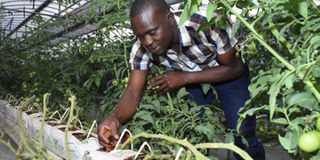Grow your vegetables vertically for a smart harvest

A farmer tends to his tomatoe verticle garden in a greenhouse
What you need to know:
Vertical gardens, too, require routine maintenance of the beds every year which demands application of manure, crop rotation and breaking the soil to ease aeration
George Katongole
Space for farming is a major concern for many urban and peri-urban farmers. Such farmers are always on the lookout for solutions that can enable them produce more from the increasingly minimal space.
Various technologies are being practiced around the country to counter the challenge, including; sack gardening (sack mound), mobile gardens, rack gardens, hanging gardens; enabling even people with compounds on lawns, pavers, tarmac or concrete to grow crops.
Another trending technique agronomists highly recommend is vertical gardening.
In several developed countries, this form of farming takes the form of aeroponics and hydroponics systems, which basically use non-soil mediums such as peat moss, coconut husks or maize husks. This system is purely indoor and plants grow under fully controlled conditions in buildings in numerous stacked layers, without solar light. This kind of farming uses more water, up to 95 per cent.
So, what is vertical gardening?
In Uganda where outdoor farming is still a major activity, vertical farming implies guiding crops on supports.
The basic supports include stakes, poles and bamboo canes. They are pushed securely into the ground at the base of plants to offer an immediate vertical hook for vining vegetables.
At first, you may need to tie in young growth to their supports to encourage them up in the right direction.
Canes or poles can be arranged in rows with a horizontal cane linking the tops to create a sturdy structure. Tie in the canes where they cross with a nylon string, twine or wire. Pre-fabricated frames are also available on which potted vegetables can be placed.
Vertical gardening yields rich rewards. By lifting plants off the ground one will enjoy bigger harvests from a relatively small patch of ground. Secondly, vegetables are easy to pick, require less weeding and can be used to create an aesthetic leafy backdrop or windbreak.
Since vertical gardening eliminates soil contact, vegetables and fruits stay cleaner and are less likely to rot.
Any vining or sprawling plant with smaller fruits can be grown in the vertical system as long as there is a sturdy, tall structure that’s strong enough to support the weight of the mature plant and resulting fruits.
Many plants do well on supports, including vegetables, cucumbers, pole beans, peas, melons, gourds, squash, pumpkin, tomatoes, French beans, flowers and sweet pea, among others.
Some plants such as beans and cucumbers are naturally climbers. You simply need to sow seeds next to a post and they will do the work. Others, such as tomatoes, need a little help: they need to be manually guided by surrounding them with twine, garden clips and even old scraps of fabric. Just be sure your method does not cut into the plant as it grows.
For some large-fruited plants such as pumpkins, melons, and large squash varieties, you may need extra support from an old shirt or other stretchy material that can be tied off to the support as the vine cannot support the fruit’s mature weight.
Hands-on
One example where vertical farming is a priority is at the novel Songhai Model site in Kampiringisa village.
With funding from the United Nations Development Programme (UNDP), the Songhai model is being taught through the Uganda’s Green Growth Incubation Programme (UGIP), with a farm-site at Kampiringisa village in Mpigi District.
The Songhai model is an intervention by UNDP to support the government through the Ministry of Gender, Labour and Social Development to address youth unemployment, increase agricultural productivity and foster sustainable growth.
The second objective, increasing agricultural productivity, is the backbone of the vertical gardening practices.
They want to help farmers to establish vertical farms where they will grow pesticide-free produce with high quality for local and international consumers.
The system prides in being purely organic with continuous use of effluents from fish, chicken and livestock waste.
Experts at the Songhai model site claim the system can increase production by four-fold compared to traditional agriculture. Such strong claims make the practice a worthy case of study for farmers with limited space.
It is time to grow up
This type of farming is favourable to both the consumer and producer. To the farmer, it reduces space constraints.
According to Samson Luwagga, an agronomist at the site, vertical gardens can get you about four or five acres of production capacity in only one acre compared to horizontal gardens.
He says it saves a lot of water compared to what would be required in normal cultivation. He suggests that crop lines can be fitted with drip irrigation pipes considerably reducing water usage up to more than 50 per cent.
Another important idea he praises is in terms of crop quality “because the crops are supported and are hardly contaminated with soil.”
Luwagga argues that farm-related accidents can also be considerably reduced since there is no need to work with heavy farming equipment.
Limitations
There are limitations though. Luwagga explains that building the stakes is cumbersome which can increase costs of setting up the farm. It is important to note that vertical gardens work with raised beds, another hectic activity that requires diligence.
Vertical gardens, too, require routine maintenance of the beds every year which demands application of manure, crop rotation and breaking the soil to ease aeration.
“Therefore, the farmers will have to pay a little more for initial costs,” he says.
Since vertical farms need to be closer to the market in order to meet the demand for fresh food, location matters a lot.
It is also critical to find out what can sell to your market. Luwagga’s priceless advice is “if you cannot sell it, you should not grow it.”




